How Art Looks at Age
Having made my weekly visit to my dear friend Alice in a senior residence—where she was committed by a state conservator—I began thinking about how society perceives older (and I refuse to use the stigmatizing word “elderly”) people. Alice is still a vital person, who calls her current domicile “prison,” which makes me sad. But she is well looked-after by caring individuals. I realized that one way to see different cultural views of older individuals is through art. It is not always how we would like to see ourselves as an older person, but it is eye-opening and often uplifting. Just a note: I changed many of these titles from “elderly” to “older” (an art historian’s prerogative).
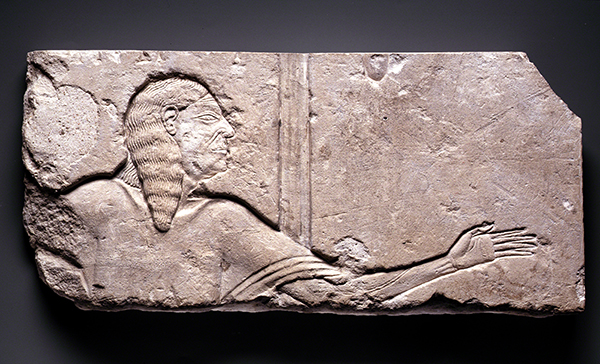 |
| Ancient Egypt, New Kingdom, Relief of an Aged Courtier, probably from Saqqara, ca. 1336–1352(?) BCE. Limestone, 5 ½" x 12 3/16" (14 x 31 cm). © 2021 Brooklyn Museum. (BMA-560) |
Akhenaten (died 1335 BCE) caused a major break in Egyptian artistic conventions for the first and only time in Egypt's history during his nearly 16-year reign. Amarna artists depicted the royal family with skinny arms and legs, elongated necks, and distended bellies and thighs, not in keeping with the sanitized, stylized naturalist conventions of the past.
This unusual depiction of an older man seems to be a hangover from the "Amarna Style." Age was never depicted in funerary depictions of the deceased, yet in this relief sagging muscle, wrinkled skin, and protruding veins leave no doubt as to the age of the deceased. The skinny, claw-like hand is also a part of the Amarna style.
Egyptian religion, like its artistic conventions, remained little changed throughout Egypt's history until the second third of the New Kingdom's Eighteenth Dynasty (1550–1292 BCE). Shortly after the reign of Amenhotep IV began around 1353 BCE, the pharaoh changed his name to Akhenaten and forced the worship of only one god, Aten, the god of the solar disk. The traditional pantheon of gods was ignored, their temples closed, and their priests forced to convert. Akhenaten built a city in the Middle Nile dedicated to Aten's worship called Amarna.
After Akhenaten's death, the cult of Aten was almost immediately abandoned; the names and deed of Akhenaten and Nefertiti, the Great Royal Wife of Akhenaten, were effaced from monuments; and Egyptian art returned to the artistic conventions of the previous 2000 years. Most of what was left of the art of Amarna were in fragments of the size of this low relief.
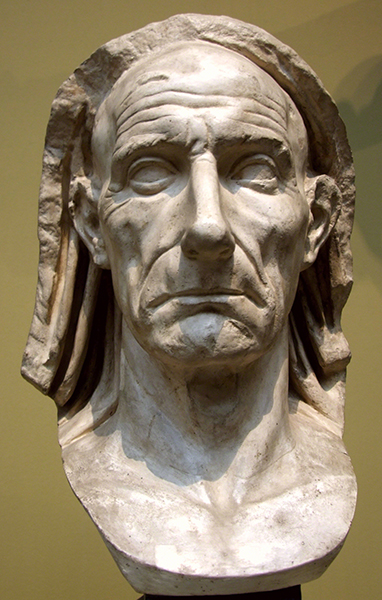 |
| Ancient Rome, Republican Period, Bust of an Older, Veiled Man, 75–65 BCE. Marble. Vatican Museums, Rome. Photo: Shakko. CC-BY-SA 3.0. (8S-30045) |
Prominent Romans commissioned wax portrait heads, often death casts, of ancestors that were displayed in public processions. Carved and modeled portraits are based on these wax heads, none of which have survived. Greeks produced portrait busts rather than heads as they felt portrait heads resembled a decapitation.
Typical of Roman Republican portraiture is a striving to render the person's features with a map-maker's faithfulness to the features. This maintained the air of simplicity stoutly espoused by even the wealthiest citizens. The hyper realism is grounded in the pathos evident in Greek sculptures of the Hellenistic Period (323–146 BCE), which ignored Classical standards of perfect beauty and physiognomy.
This realism is evident in this late Republican bust of an older man. His thinning hair, sagging jowls, and wrinkled neck would have appalled Classical Greek artists. However, the Roman artist has managed to instill a sense of dignity to the sitter. Despite the emphasis on extreme realism, there is a psychological reserve that clearly puts this genre outside of any Greek influences, particularly works from the Hellenistic period.
From the 600s to the 500s BCE, Rome was ruled by kings of Etruscan lineage. From the Etruscans, the Romans learned maritime trade, metalworking, and architecture. The Etruscans had assimilated Greek art and religion through trade, and what the Romans did not learn from them, they borrowed from the Greek colonies in southern Italy. By the end of the 500s BCE, Rome was a major trading hub. Rome controlled the entire peninsula of present-day Italy by 275 BCE, conquering Carthage in north Africa and controlling the western Mediterranean by the mid-100s BCE. At the same time, they conquered Macedonia and Greece. By 40 BCE, Rome had conquered most of Gaul (present day France) and the eastern Mediterranean.
While Greek artists stressed idealized, physical perfection of the human figure, Roman artists did not share the idea of physical perfection reflecting the divine. Romans were scornful of the luxurious ease of the Etruscans and Greeks. They were proud of their austere virtues and military valor. This glorification of their military past is reflected in an overall ancestor worship that manifests itself in portrait sculpture starting in the Republican period.
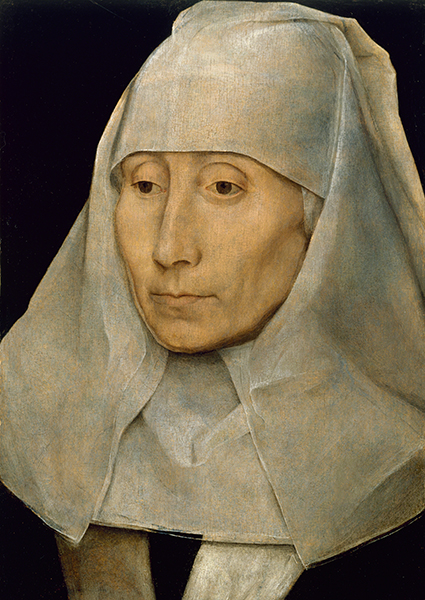 |
| Hans Memling (ca. 1430/1433, Germany, died 1494, Flanders), Portrait of an Older Woman, 1468–1470. Oil on wood panel, 10" x 7" (25.6 x 17.7 cm). © 2021 Museum of Fine Arts, Houston. (MFH-41) |
Unlike Italian portraiture of the Renaissance, Flemish portraits refrained from overt idealization of the sitter based on the standards of beauty in classical art. Northern artists were interested in observed realism, although they lacked the anatomical training of their Italian counterparts.
Hans Memling's portraits convey an inner strength and dignity. Although the older woman's features in this portrait are plain and sharp, his framing them in a brilliantly rendered, diaphanous head piece (called a “wimple,” worn by married women) lends her close-up portrait a quiet monumentality.
From 1361 through 1477, the Duchy of Burgundy, which was related to the French crown and included parts of the Netherlands and the county of Flanders (present day Belgium), was one of the richest courts in Europe. The cities of Burgundy were enriched by trade, particularly in the textile business, and the rapidly improved standard of living of the middle class produced a wealth of new art patrons that helped usher in the Renaissance in the 1400s.
More so than in Italy, painting in Northern Europe grew out of the sophisticated genre of manuscript illumination. With the advent of renewed interest in observed realism during the late 1300s, manuscript illustrations became miniature masterpieces of painting. When the idea of depicting depth and space became an important aspect in manuscript illumination, the natural result was for it to blossom into panel painting.
Although Bruges declined in prosperity in the late 1400s because its harbor began silting up, thus disrupting trade, it and Brussels persisted as active centers of Renaissance painting well into the 1500s. The union of Flanders after 1477 to the Holy Roman Empire Hapsburgs through the marriage of Mary of Burgundy (1457–1482) opened new avenues of artistic patronage from throughout the Germanic states. Thus, the influence of the Flemish Renaissance style spread to German territories. Memling, a German born in Seligenstadt, became the leading painter in Bruges in the last quarter of the 1400s.
Memling appeared in the Bruges citizen roll in 1465, where he was already a master in the painters' guild. Due to technical aspects of his work, he is thought to have worked in the shop of Rogier van der Weyden (1399/1400–1464). He capably accomplished the Flemish style of observed realism, sculptural monumentality, and richness of surface in oil painting. However, his serene, elegant, relaxed compositions lack the poignant drama seen in Rogier's religious works and the inner turmoil of his contemporary, Hugo van der Goes (1436–1482).
From Rogier, Memling received the strong conceptual formats and iconography in religious works. Like Rogier, many of his patrons were expatriate wealthy Italians, as well as agents of the Medici family, including the Portinari, who had also patronized Rogier.
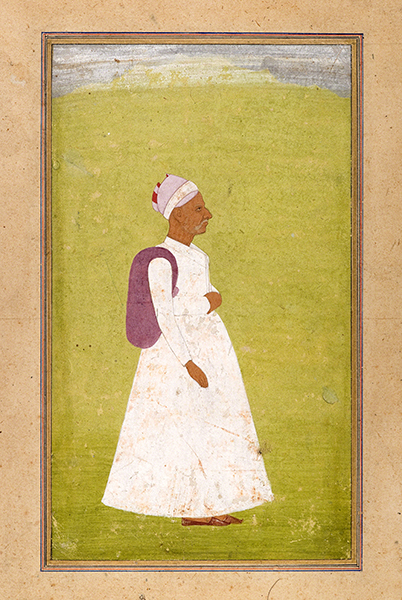 |
| India, Mughal Empire, Portrait of an Older Man, from Rajasthan, ca. 1730. Opaque watercolor on paper, sheet: 9 3/8" x 5 7/16" (23.8 x 13.8 cm). © 2021 Brooklyn Museum. (BMA-3568) |
Indian portrait paintings often depict their subjects standing in profile against a plain backdrop. In this delicate portrait, an unidentified older man wears relatively humble clothing; he lacks jewelry, a sword, or the decorative sash usually sported by courtiers of the period. The emphasis of the painting seems to be on the sensitive rendering of his wrinkled face and on the unusual purple sack that he carries over one shoulder. It is likely that this man was an honored artist or scholar, someone worth celebrating in a courtly portrait, but not a member of the aristocracy.
Deriving from Persian artistic techniques, Mughal portraiture reached its highest point during the reigns of the great Mughal emperor-patrons Akbar (1542–1605), Jahangir (1569–1627), and Shah Jahan (1592–1666). Mughal imperial portraiture was produced to disseminate throughout the Mughal holdings as reinforcement of the ruler's prestige, power, and influence. This courtly style influenced other regional painting schools, even after the decline of the Mughals post-1739, particularly Rajasthan.
While Western realism was one of the influences derived from Persian sources in Mughal painting, official portraiture followed conventions just as rigid as those of ancient Egyptian art. Indeed, some of these conventions date back to ancient Near Eastern art. The combined frontal-profile view of figures and shallow relief-like space are traceable as far back as Assyrian art (700s–800s BCE).
In 1526, the Turk/Mongol leader Babur (1483–1530) founded the Mughal Empire when he invaded and conquered northern India (including Pakistan). Under Babur’s successors, especially the emperor Akbar, the empire grew to dominate most of the subcontinent of India.
The Mughal emperors tolerated the other major faiths of India, such as Hindu and Sikh. The exception was Aurangzeb (1618–1707), son of Shah Jahan, who tried to abolish the Sikh sect. Aurangzeb, a conservative Muslim, disapproved of music and art, and as a result the arts declined during his reign. Unlike his predecessors, he started no major building campaigns.
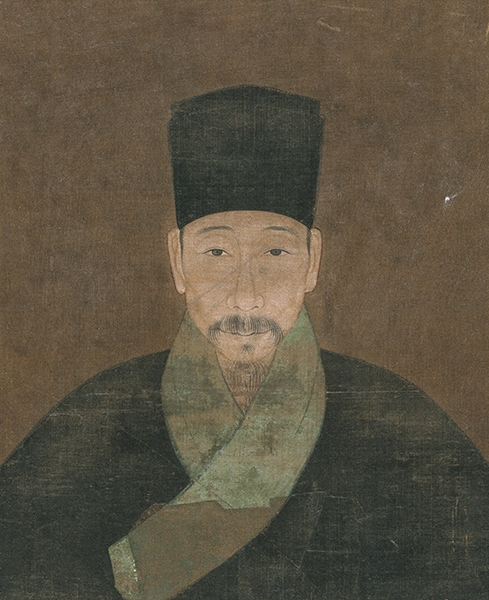 |
| Korea, Portrait of a Scholar, 1700s. Ink and color on silk, 11 ¼" x 9" (28.6 x 22.9 cm). © 2021 Philadelphia Museum of Art. (PMA-2973) |
The dignified treatment of a scholar’s portrait is evidence of the influence of Chinese culture in its veneration of the scholar sector of society. The professional artist who painted this portrait followed the Korean tradition of truthful translation of the sitter's features onto silk. They did not flatter their sitters, for they believed that if even one hair was out of place, it was a different person. This reflects the Confucian ideal of being true to oneself.
The direct frontal gaze and unvarnished realism of the features was meant to convey the true character of the scholar. It is executed in the same linear contours seen in landscape painting, with little interest in the illusion of volume. He wears the dongpagwan, a horsehair hat worn indoors by scholars and noble men.
The earliest historical record of developed painting in Korea is found on painted baskets from the first 100 years BCE. A more substantial record of ancient Korean painting remains on the painted walls and ceilings of tombs from the Three Kingdoms Period (57 BCE–668 CE). Those paintings reflect Buddhist beliefs. During the Joseon period (1392–1910), Confucian beliefs rivaled Buddhism in popularity, with an emphasis on scholarship and the artist/scholar idea always part of Chinese art.
During the Joseon period (1392–1897) there was a differentiation between professional artists (hwanjaeng-i) and the literati/scholar/amateur artists of the nobility. The hwanjaeng-i were looked upon as inferior. They faced government rules and regulations of their art form, and were obliged to provide portraits of religious figures, high officials, and nobility, as well as to document important official events artistically.
The Koreans suffered greatly during the second half of the Joseon Dynasty (ca. 1590 onwards), first from Japanese invasion and then at the hands of Chinese armies, which came to Korea’s aid and stayed on to pillage. By the 1700s, peace in China and Japanese isolation brought somewhat better conditions to Korea. Paintings of this time reflect the greater degree of independence Korea in their subtle elements of indigenous stylistic variations.
.jpeg) |
| Alice Neel (1900–1984, U.S.), Last Sickness, 1953. Oil on canvas, 30" x 22" (76.2 x 55.9 cm). Courtesy of Philadelphia Museum of Art. © 2021 Estate of Alice Neel. (PMA-9560) |
This is one of four portraits Alice Neel painted of her dying mother, Alice Hartley Neel, when they lived together in New York. We see the empathy and compassion Neel brought forth for her sitters in this work, which was painted only a few months before her mother died in 1954. The loving mother-daughter dynamic is captured brilliantly and is poignantly rendered public.
The dubious look on her mother’s face did not prevent Neel from showing every nuance of a dying woman, confronting old age head on with dignity. Neel’s rendition of her mother is both frank and sensitive, with no judgment or affectation imposed on the subject, a hallmark of all of her portraits.
Neel's portraits are most famous for their green and violet shadows, which give the sitters a monumentality, no matter how casual the pose or outfit. This bravura brush work extends to her mother’s wonderfully rendered bathrobe. The brilliant yellow of the lemons in the background are a contrast to the sitter’s apparent resignation to the realities of time.
Starting in the late 1900s, the climate of opportunities for women artists to forge careers and exhibit their work greatly improved. This is credited to feminist artists in the 1970s who boycotted major museums, and individual art historians who wrote articles in scholarly journals. Of the many art movements of the late 1900s, women have participated fully in all of them. The return to figuration was one of the most vigorous trends in which women artists participated.
For certain women, like Alice Neel, the increased opportunities did not benefit her until late in her life. Born in rural Pennsylvania with oppressive parents, Neel knew from an early age that she wanted to be an artist. She studied commercial art at the Philadelphia School of Design for Women and later at the Pennsylvania Academy of Fine Arts, where she studied painting.
The repression of Neel's childhood and her abject poverty gave her portraiture an expressionistic and empathetic edge that was not well received by either patrons or galleries. This notwithstanding, she received her first one-person show in Havana during a visit with her Cuban husband (the marriage was short lived).
Returning to America, Neel lived a bohemian life as an artist in New York. During the 1930s, she survived by participating in Works Progress Administration (WPA) art projects. Even there, she found work difficult to come by as the institutions that were supposed to sponsor WPA artists did not like her expressionistic painting style. She did, however, hone her portraiture into the style for which she became renowned throughout the rest of her career.
Even with the return of figuration in the 1960s, Neel’s work was not widely accepted, and she was pointedly left out of the Museum of Modern Art’s 1962 exhibit Recent Painting U.S.A.: The Figure, a show that highlighted mostly abstract art. However, she was noticed by a prominent art critic and given her first one-person show in America at the Graham Gallery in New York, which exhibited her work frequently until her death.
Neel ignored modern American movements from Abstract Expressionism through Minimalism and Conceptual Art. She also did not follow the trend of New (Photo) Realism that emerged out of Pop Art. Her portraits were not photo-realistic, but she was able to capture the intensity and character of her sitters through her energetic brush work and often lurid color.
|
Jordan Casteel (born 1989, U.S.), Yvonne and James, 2017. Click to view this artwork on the artist’s website. Oil on canvas, 90" x 78" (228.6 x 198.12 cm). © Jordan Casteel. Photo: Jason Wyche. |
Denver native Jordan Casteel is an artist who brings into sharp focus the lives of African Americans and other people who are not typically the central subject of contemporary art. Living in Harlem, she has documented the lives of many diverse elements in the neighborhood, always with dignity and monumentality. As one of her subjects put it:
Putting aside Jordan’s skills as an oil painter, I think her gift is to capture these moments and send a message to the world that even the common Joe at the barbershop, the common barber, the common individual in the community, on the bus stop, is worthy of being celebrated. — Denver barber Marcus Pope, 2018 subject of Marcus and Jace, 2015, via Boulder Weekly
Casteel uses a camera to capture her encounters with her subjects, allowing her to slow down boisterous street life and provide enough detail of the individuals that she interacts with so that she can come back to them—studying their mannerisms, what they wear, and even their inner lives—when she returns to her studio. The camera helps her, and us by extension, give a detailed focus on her sitters.
Casteel tells the story about her painting of Yvonne and James at the Cantor Arts Center. The talk gives us a glimpse into the relationship of this couple the artist met in Harlem, and how these two characters became as much part of Casteel’s life as they are now part of her portfolio.
Correlations to Davis programs: Explorations in Art 2E Grade 1: 2.1, 2.2; Explorations in Art 2E Grade 2: 2.2; Explorations in Art 2E Grade 3: 1.1, 1.2; Explorations in Art 2E Grade 4: 2.1; Explorations in Art Grade 6: 1.1, 1.2; A Personal Journey 2E: 6.4


Comments